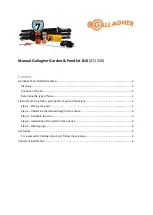
May 22, 2023
EZ-SCREEN SLS Safety Light Curtain Instruction Manual
39
•
•
•
Reduced Resolution increases the minimum diameter of an object that the light screen can reliably detect anywhere within its
defined area. Reduced Resolution is generally used to allow one or more objects (usually workpiece materials) to move any-
where through the defined area, without tripping the OSSD safety outputs.
Enabling two-beam Reduced Resolution reduces the overall minimum object sensitivity, which allows multiple objects to
move through the defined area. The effect is that any two consecutive beams (except for the sync beam) can be blocked,
without causing the OSSDs to turn OFF. This is also called “Multiple-Point Floating Blanking.”
Multiple “holes” are created in which 14 mm systems detect a 30 mm object and ignore an 8.5 mm object. Similarly, 30 mm
systems detect a 60 mm object and ignore a 17 mm object. See the DIP-switch configuration. During operation, the Status in-
dicator flashes green when reduced resolution is enabled.
In reduced resolution applications, the separation distance always increases because of the larger depth penetration factor
(Dpf). In either case, calculate the separation distance (see
"Calculating the Safety Distance (Minimum Distance)" on page
Model
Reduced Resolution Setting
Maximum Size of Undetected Objects
Resulting Resolution
14 mm Resolution
Off
(Not applicable)
14 mm (0.55 in)
On (2-beam)
8.5 mm (0.34 in)
30 mm (1.18 in)
30 mm Resolution
Off
(Not applicable)
30 mm (1.18 in)
On (2-beam)
17 mm (0.67 in)
60 mm (2.36 in)
WARNING:
Use reduced resolution and fixed blanking only when necessary
Failure to follow these instructions could result in serious injury or death.
Completely fill any holes created in the sensing field with the blanked object or increase the safety
(minimum) distance to account for the larger resolution.
Fixed blanking allows for a stationary object(s), such as tooling, to be ignored while it remains positioned within the defined
area. A flashing green Zone indicator denotes the location of a blanked area. If the object is moved or removed, the System
enters lockout mode so that an unexpected hole in the sensing field is not created.
One or multiple areas within an
EZ-SCREEN SLS
sensor pair may be blanked out. The minimum number of beams between
two blanked areas is one. Any beam other than the sync beam may be blanked. All beams of a fixed blanked area must stay
blocked at all times (after the fixed blanking configuration mode has been exited), for the OSSDs to stay ON.
Reduced Resolution/Floating Blanking
5.8.5
Fixed Blanking
5.8.6
Configure Fixed Blanking
From normal operation or a power off condition, move the second and third DIP switches (the first RR and T/L) both
to the left (T and RR position).
NOTE:
The fixed blanking process has a time limit of 10 minutes. If this time is exceeded, a lock-
out occurs and the process must be started over.
1.
Move the fourth and fifth DIP switches (the second RR and T/L) both to the right (L and OFF position). The first and
sixth DIP switches are not part of this process. Do not move them to match this image.
2.
© Banner Engineering Corp.
Summary of Contents for EZ-SCREEN SLS
Page 16: ...May 22 2023 EZ SCREEN SLS Safety Light Curtain Instruction Manual 16 Banner Engineering Corp...
Page 52: ...Blank page 52...
Page 68: ...Blank page 68...
Page 90: ...Blank page 90...
Page 102: ...Blank page 102...
Page 106: ...Blank page 106...
Page 114: ...LinkedIn Twitter Facebook 2023 All rights reserved www bannerengineering com...
















































